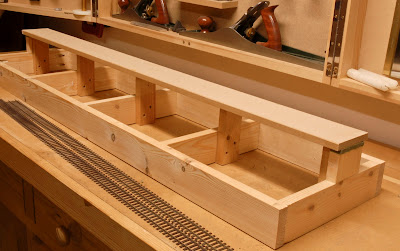...well almost!
I must admit that if you had told me that I would be considering adding sound to a model railway 20 years ago I would of told you that was the last thing I would do. Today sound has come on a long way from the the vinyl LP record of steam/diesel train sounds and the portable record player. Digital Command Control (DCC) has revolutionised the concept completely with sound chips and on-board speakers as well as resynchronisation of the sound to the actions of the locomotive. The ability to programme the chips (easily) from the hand-held controller make it all the more attractive.
 |
| Silent Running - we hope! |
Sounds good? Yes, but for me there is still a problem - it' TOO LOUD! Go to any model railway exhibition and you will see fantastic layout where superb attention to detail has been lavished on all the visual aspects. Trains are run at realistic speed within a well throughout operating schedule the sound is so load that they are audible even when out of sight. and far away. Having never exhibited a layout with sound I can only presume there are a couple of reasons for this. One maybe the operator is in the wrong place to be able to judge the volume from the viewer's position and increases the volume until he (or she!) can hear it. As most DCC controllers (other than the most basic units) are walk-around models, either wired or wireless, there is no real excuse for this.A more likely explanation is that the volume is cranked up to mask the roar that is generated and then amplified by the baseboards as the train runs along a solidly laid track and track bed.
Wouldn't it be nice if the viewer could hear a train in the distance only faintly and the sound to become crisp as the train passed buy and to diminish as it disappears into the distance. This does happen on some of the larger layouts as physical distance will make this happen. But what if your layout is not 40ft long? The only way to do it is to reduce the volume coming from the on-board sound system and to drastically reduce the mechanical noise created by the train running over the layout. One way to do this is to introduce mass into the baseboards. Filling them with concrete would do the trick but my make them a bit on the heavy side! Another solution is to mechanically disconnect the track and the trackbed from the baseboard framework yet still holding it in place.
 |
The plywood-underlay-plywood sandwich is very strong
but time consuming and pricey
|
|
To this end I have been experimenting with laminated floor underlay tiles and have built sections of rail bed laminated up from plywood-underlay-plywood sandwich. Although this system is very strong when dry, and would need fewer supports over a given length than convention single sheet road bed, it is not cheap and involves a lot of fabrication. A much simpler method I am testing at the moment involves using small pads of the underlay material glued to the top of the risers and the track bed glued to the pads with no screws or nails. This
should dramatically reduce the transmitted noise between the road bed and the frame.
 |
| The risers shown here with the underlay pads separating them from the track bed |
The next step will be to separate the ballasted track, which will be laid on ⅛ inch thick cork, from the road bed using ⅛ inch thick high density foam. Come back over the next few days and see how successful the sound proofing is.
Ralph.
To make sure you don't miss anything,
sign up for free e-mail alerts
at the top left of this page!



No comments:
Post a Comment